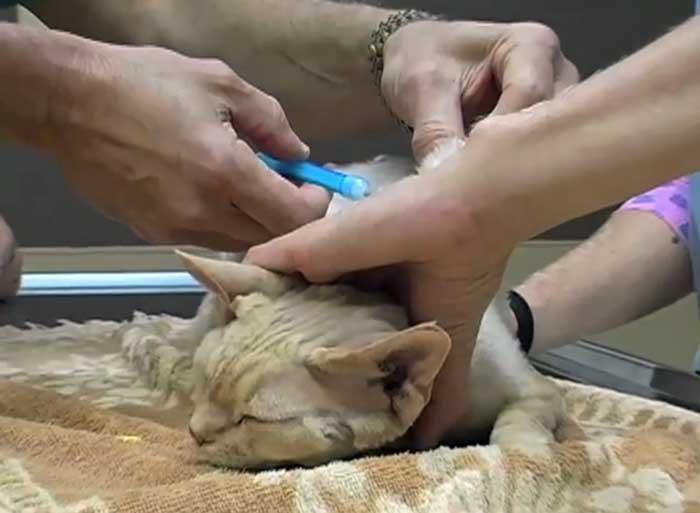
There are it seems two aspects of concern in relation to microchipping pets including cats:
- Whether it is effective
- Whether it is safe
They last for about 25 years. This produces a registration number from which data can be accessed such as owner and address. They are FDA authorized in the USA. You can buy microchip scanners on Amazon. This allows anyone who finds a lost cat to check for a microchip. The data on the chip is not always up-to-date. Jackson Galaxy reminds us to ensure that it is on TikTok. Here is a video of a microchip being implanted.
Too many microchips are not updated and are therefore useless.

Effectiveness
There is no doubt that it is effective, in more ways than one. It is not uncommon to see stories in the press about cats that were lost and then found because of microchipping. A recent (as at 2012) story is a good example. It concerns, “Dopey”, a long legged, rather rangy, ginger tabby moggie cat. He went missing in Sacramento, USA, about 6 years ago and thanks to microchipping was found again. In between getting lost (“went missing”) and being returned he passed through the hands of two other human companions. When the second died, he was taken to the Yolo County Animal Shelter in Woodland. The staff discovered an American Kennel Club (AKC) Companion Animal Recovery chip under his skin.
The “owner” was very surprised, unsurprisingly! Anyway, a happy ending thanks to the process of microchipping pets including cats. Here is a sweet ginger tabby cat at a shelter who was not microchipped. He is stressed and won’t eat. He was someone’s cat companion as he is domesticated but the shelter staff will have to try and rehome him. There is no guarantee that will happen which puts his life at risk. Microchips saves lives. There are very many reunions of lost cats and owners thanks to the humble microchip.
Another benefit that we might occasionally use is the microchip sensitive cat flap. These are becoming increasingly common it seems. They are designed for the outdoor cat and act as a kind of cat key letting in the cat with the microchip and none other including those part-time cats, stray cats and feral cats.
Deceased cats
There is a campaign in the UK to make it mandatory for local authorities to collect all cats killed on the road and scan for a microchip to allow them to return the body to their owner. At present they do not have this obligation. Many cat owners are left in the dark as to what happened to their lost cat. I am sure that councils in the USA are also not under this obligation. I think it is a good idea. Can someone from the US comment on this?
RELATED: Checking a cat for a microchip at home (and reuniting a lost cat with owner)
Microchipping Pets including Cats – Safety
First microchipping is considered safer than cat collars (new window). Microchipping is safer in terms of the physical danger (possible strangulation) of a cat collar but is it completely safe to implant something like this inside a living creature? Research on mice indicates a 1-10% chance of development of a malignant tumour around the microchip.
There have been reports about tumour induced microchipping of pets (11, it seems, over 1990-2006 in the UK). The reports were reviewed by Katherine Albrecht in November 2007. The report is called, “Microchip-Induced Tumors in Laboratory Rodents and Dogs: A Review of the Literature 1990–2006“. Tumours developed around or close to the site of the implanted microchip in between 0.8% and 10.2% percent of the tested animals. It is believed that the microchip has a negative impact on the genetic make-up of the adjacent cells. The microchip acts as a genotoxic object (a substance that can cause damage to DNA material). However, it would seem that millions of cats and dogs have been microchipped with no significant reports of cancer indicating that the benefits outweighing risk but please do your own research.
Another problem is that microchips can migrate (move) from the back of the neck where they are implanted to the shoulders and sides. The cost of implantation may include lifelong registration (usually does). Petlog, a branch of the Kennel Club run a registration service in the UK. If you move, you’ll need to update the database. This may incur a small charge.
GPS microchip trackers
Another development is GPS (global positioning system) microchipping. This sounds spectacularly good as it avoids the fact that someone has to scan the microchip and then locate the owner. Perhaps they have moved and not updated the microchip. With the GPS system the owner can track down his or her pet herself. This seems to come from the big brother concept of microchipping prisoners (people)! I am not sure how far this has developed. Update 2022: there are no GPS tracker microchips as yet. I think it is a miniaturisation problem. There are radio frequency microchips but these are short range tracking devices. You can fit a GPS tracker to a cat but they are fairly bulky. I have a radio tracker collar for my cat. As cats are normally lost within 500 metres of home and these radio trackers can detect at 150 metres plus, they a pretty useful and modestly priced.
Microchipping Pets including Cats – Conclusions
The indications are that the benefits outweigh the possible health issues. Routine inspections (by touch) around area of the implanted microchip and surrounding areas seems sensible. Perhaps on a visit to the vet it could be scanned to see if has moved etc.
Microchipping Pets including Cats to Cat health problems
Sources:
- Myself – out of my head
- www.antichips.com
- For the Love of the Dog
- Wikipedia (on definition of genotoxic)
- Petplace.com
- The pet medic
- http://www.tldm.org/News4/Markofthebeast.htm



Comments are closed.